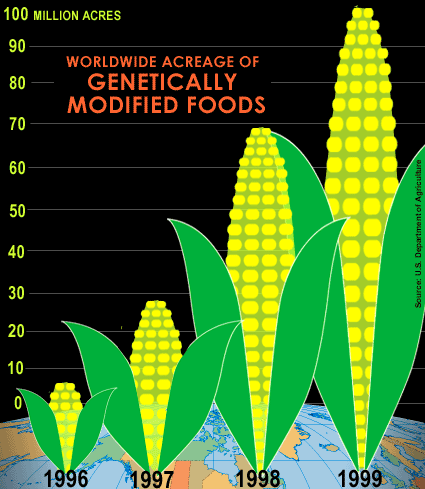The European Food Safety Authority (EFSA) has belatedly discovered that the most common genetic regulatory sequence in commercial GMOs also encodes a significant fragment of a viral gene. The finding – published quietly in a new journal [1] - has serious ramifications for crop biotechnology and its regulation, but possibly even more so for consumers and farmers. There are clear indications that this viral gene (called Gene VI) might not be safe for human consumption, although the authors fall short of stating that. It also may disturb the normal functioning of crops, including their natural pest resistance. The authors, Nancy Podevin from the European Food Safety Authority (EFSA) and Patrick du Jardin at University of Liege in Belgium, discovered that of the 86 different transgenic events (unique insertions of foreign DNA) commercialized to-date in the United States 54 contain portions of Gene VI within them. They all have the regulatory sequence called the CaMV 35S promoter (from the cauliflower mosaic virus CaMV), the most commonly used for driving gene expression in GMOs. The events therefore include some of the most widely grown GM crops all over the world such as Roundup Ready soybeans (40-3-2) and MON810 maize. Also included is the controversial NK603 maize recently reported to cause tumours in rats [2] (see also [3] GM Cancer Warning Can No Longer Be Ignored, SiS 56).
The researchers themselves concluded that the presence of segments of Gene VI “might result in unintended phenotypic changes.” They reached this conclusion because similar fragments of Gene VI have already been shown to be active on their own [4]. In general, viral genes expressed in plants raise both agronomic and human health concerns [5, 6]. That is because many viral genes function to disable their host in order to facilitate pathogen invasion, often by incapacitating specific anti-pathogen defences. Incorporating such genes could clearly lead to undesirable and unexpected outcomes in agriculture. Furthermore, viruses that infect plants are often not that different from viruses that infect humans. For example, sometimes the genes of human and plant viruses are interchangeable, while on other occasions inserting plant viral fragments as transgenes has caused the genetically altered plant to become susceptible to an animal virus [7]. Thus, in various ways, inserting viral genes accidentally into crop plants and the food supply confers a significant potential for harm. (Editor’s comment: there is also evidence that the CaMV 35S promoter may actually induce transcription factors for HIV and other pathogenic viruses [8] New Evidence Links CaMV 35S Promoter to HIV Transcription, ISIS scientific publication.)
References:
1. Podevin N and du Jardin P. Possible consequences of the overlap between the CaMV 35S promoter regions in plant transformation vectors used and the viral gene VI in transgenic plants. GM Crops and Food 2012, 3, 1-5.
2. Séralini G-E, Clair E, Mesnage R, Gress S, Defarge N, Malatesta M, Hennequin D, de Vendômois J-S. Long term toxicity of a Roundup herbicide and a Roundup-tolerant genetically modified maize. Food and Chemical Toxicology published online September 2012. http://dx.doi.org/10.1016/j.fct.2012.08.005
3. Saunders PT and Ho MW. GM cancers can no longer be ignored. Science in Society 56, 2-4, 2012.
4. De Tapia M, Himmelbach A, and Hohn T (1993) Molecular dissection of the cauliflower mosaic virus translation transactivator. EMBO J 12: 3305-14.
5. Wilson AK, Latham and RA Steinbrecher (2006) Transformation-induced mutations in transgenic plants: Analysis and biosafety implications. Biotechnology and Genetic Engineering Reviews 23: 209-234.
6. Latham JR, and AK Wilson (2008) Transcomplementation and Synergism in Plants: Implications for Viral Transgenes? Molecular Plant Pathology 9: 85-103.
7. Dasgupta R , Garcia BH, Goodman RM (2001) Systemic spread of an RNA insect virus in plants expressing plant viral movement protein genes. Proc. Natl. Acad. Sci. USA 98: 4910-4915.
8. Ho MW and Cummins J. New evidence links CaMV 35S promoter to HIV transcription. Microb Ecol Health Dis 2009, 21, 172-4.
Source: ISIS, 28 January 2013
http://www.i-sis.org.uk/Potentially_Dangerous_Virus_Gene_in_GM_Crops.php

- Login om te reageren
